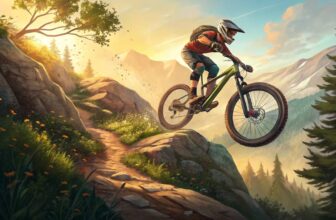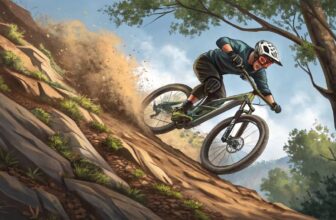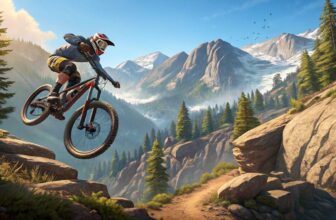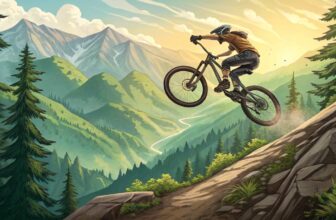Understanding Body Position
Let’s talk mountain biking. If you want a smooth and safe ride, nailing your body position is key. It’s not just about looking cool on the trails; it’s about making sure your whole biking experience is top-notch.
Importance of Proper Body Position
Getting your body position right on a mountain bike is like having superpowers for balance. Your core is the hero here, helping you handle the bike like a pro. When you’re balanced, it’s like everything clicks into place. Suddenly, you’re cruising over rocks and roots with confidence, not clinging on for dear life.
The magic happens when your Center of Gravity (COG) matches up with the bikes. Get it right, and you’re unshakeable; get it wrong, and you feel like a wobbly mess. Whether you’re just starting or you’ve been tearing up trails for years, mastering this can turn your ride from ‘meh’ to ‘wow’.
Fundamentals of Body Balance
When it comes to balancing on a mountain bike, think simple. You want a straight spine and to hinge at your hips. It’s like lifting weights at the gym – keep it centered. Make sure your weight’s spread out evenly on both wheels for that sweet spot of stability.
Your bike’s geometry plays into this more than you’d think. Got a shorter torso? You might find a steeper seat tube angle right up your alley. Bigger build? A slacker angle could be your new best friend. These adjustments help keep you comfy and balanced.
Here’s a quick rundown:
| Rider Aspects | What You Need to Do |
|---|---|
| Core Engagement | Keep that spine straight and your core tight for balance |
| Hip Hinge | Bend at the hips, like you’re pulling a deadlift |
| COG Alignment | Match your COG with the bike’s COG |
| Seat Tube Angle (STA) | Tweak based on your torso length for the best balance |
Nailing these basics is a game-changer for anyone on a mountain bike. For more tips and tricks, check out our guides on mtb tire pressure and mtb suspension setup.
Mountain Bike Geometry
Getting the hang of a mountain bike’s shape and design can make or break how awesome your ride feels. Stuff like the way the seat tube and the head tube angle matter a ton for your comfort, control, and how well you perform on various trails.
Seat Tube Angles and Their Impact
The seat tube angle (STA) is a biggie in mountain bike design. These days, especially for Enduro and Trail Bikes, folks are leaning towards steeper angles, like 74 to 78 degrees, instead of the old-school 73 degrees. Such angles change the game when you’re dealing with climbs and drops.
| Bike Type | Steep STA (74-78 degrees) | Historical STA (73 degrees) |
|---|---|---|
| Enduro/Trail Bike | Better climbing control | Less control on uphills |
| Downhill Bike | Enhanced downhill stability | Better overall balance |
Steeper STAs keep you over the pedals during climbs, stopping your front wheel from doing its own dance, though this means you’ll need a chilled-out head tube angle to keep your wits on the way down.
Let’s face it, body shape matters too. A rider who’s got a shorter torso might dig those steeper angles for more comfort, while long-torso folks might want it slacker for better balance.
Head Tube Angles for Stability
The head tube angle (HTA) is like the steering wheel that keeps your bike on point, especially as you’re zooming downhill. Back in the day, bikes had stiff HTAs, but the cool kids now are opting for slacker ones in Enduro and Downhill bikes.
| Angle Type | Steeper HTA (67-69 degrees) | Slacker HTA (63-66 degrees) |
|---|---|---|
| Terrain | Tight, technical trails | Steeper descents, high speed stability |
| Maneuverability | Higher | Lower |
| Control | Less stability in fast descents | Enhanced stability |
With a slacker HTA, you’re rock solid on super fast descents but might have to work a bit to dodge and weave through tricky stuff.
Finding the sweet spot between STA and HTA is like tuning a guitar. It all hinges on what kind of action you’re seeking and how you’re built. Playing around with various setups can really make all the difference.
For a deep dive into setting up these angles right, check out our tips on mountain bike sizing. Don’t sleep on the importance of bike tuning in our bike fit and geometry section, and always keep your noggin safe with our mountain biking safety tips.
Rider Posture Techniques
Mountain biking isn’t just about pedaling; it’s all in the way you hold yourself. Good posture is key for a smooth ride, keeping you safe, and upping your game. Let’s break it down with the attack position and some cool tips for going up and down hills.
The Attack Position
Ready, set, attack position! This is your go-to stance when things get bumpy out there on the trail. It’s about staying loose and letting your bike do its thing while you hover smoothly above it. Here’s how to nail it:
Bend Them Knees and Elbows:
- Let those joints flex like shock absorbers.
Chest Down, Not Out:
- Lean forward, bringing your chest close to the bars.
Hips Back It Up:
- Slide your hips back like you’re chillin’ at the rear of the seat.
Easy Grip, Tiger:
- Hold the bars firmly yet gently—like shaking hands, not wrestling.
Eyes on the Prize:
- Keep your peepers looking far ahead to scope out what’s coming.
These moves make you nimble, perfect for dodging tricky trails. Want to know more about basic skills? Check out our mountain biking basic skills article.
Climbing and Descending Strategies
Climbing Strategies
Climbing is all about being a balancing act between the wheels to keep you glued to the earth. Try these on your next uphill battle:
Lean In:
- Dip your chest forward to keep that front wheel planted.
Push Those Hips:
- Move forward to grip that back wheel tight.
Elbows Tucked:
- Pull those elbows in for a sleek ride.
Steady as She Goes:
- Keep those pedals turning smoothly so you don’t stall out.
Crack these techniques, and you’ll conquer those climbs like a boss. For more uphill wisdom, peep our section on mtb technical climbing.
Descending Strategies
Going down? Stay cool with a solid body stance to roll down safely:
Stay Low:
- Lower your chest to hug the bike and stay stable.
Weight Back:
- Shift back to prevent nose-dives.
Flex the Elbows and Knees:
- Let them absorb the terrain’s tantrums.
Gaze Forward:
- Check out what’s coming, not what’s under your nose.
Heels Down:
- Keep those heels dropped for better balance and control.
With these tips, sliding down steep slopes becomes less scary. For more descending tricks, have a look at our mtb drop technique.
Summary Comparison Table
| Technique | Key Points |
|---|---|
| Attack Position | Bent knees/elbows, chest low, hips back, relaxed grip, eyes forward |
| Climbing | Chest down front, hips up, elbows in, steady pedaling |
| Descending | Chest low, weight back, flexed elbows/knees, gaze forward, heels low |
Master these posture techniques and watch your biking skills level up. Up for some advanced tricks? Don’t miss our how to jump mtb guide.
Get Movin’: Improve Your MTB Game
Getting your body to move just right is a big deal when it comes to acing mountain biking and cranking up your ride’s mojo. Knowing the nuts and bolts of how to hold yourself on that two-wheeler ain’t just book stuff—it’s about making your whole biking experience awesome. To improve your body movement, it’s key to nail down the art of hip bending and fortifying that core.
The Hip Thing: How to Bend Right
Bending at your hips while keeping your back in line will keep you steady on a mountain bike. It’s kinda like pulling off a deadlift at the gym. There’s this fella, James Wilson, who trains folks good enough to ride in things like the World Cup. He says knowing the moves is solid advice but putting them into action is where the magic happens.
Mastering the hip hinge lets cyclists:
- Smooth out bumps and thumps from the trail.
- Steady themselves over the bumpy and weird terrains.
- Shift their weight quickly for slick handling of the bike.
You can beef up your hip hinging with moves like the Bulgarian Goat Bag Swing. A fitness guru, Dan John, vouches for it. This workout fires up the hips, core, and upper back, setting you up for the right biking posture.
| Exercise | What It Does | Who It Works |
|---|---|---|
| Bulgarian Goat Bag Swing | Boosts bike posture, fires up the hips | Hips, Core, Upper Back |
Focusing on making your hip hinge loose and strong is vital since stiff or lazy hips can mess with your bike posture.
Core Power: Keepin’ It Steady
A beefy core is what keeps you steady and solid while you’re ripping trails. It props up your top half, cuts down on getting worn out, and helps control. Locking in your core during rides lets you move smoother and gets you climbing and dropping faster.
| Workout | What It Does | Muscles Targeted |
|---|---|---|
| Planks | Boosts core power | Abs, Lower back |
| Bicycle Crunches | Cranks up core staying power | Obliques, Abs |
Regular core-moving workouts like planks and bicycle crunches will ramp up your bike balance and control.
Testing and upping your core strength on the go? Try standing climbs. This demands a solid core to keep you steady while pedaling, so you’re not swaying like a ship at sea.
By diving into these tricks, cyclists can sharpen their MTB stance, steer better, and dodge injuries. Want more tips on rocking the ride? Check out our pages on mtb braking techniques and mtb cornering techniques.
Injury Prevention
Getting the right body stance is key when tearing up mountain trails on your bike. Equally important is being street-smart about the potential risks while cruising along. Knowing the deal and playing it safe can mean more pedal time and fun in the long run.
Overuse vs. Traumatic Injuries
Most mountain biking oopsies fall into two camps: injuries that sneak up on you and those that hit you like a ton of bricks.
Overuse Injuries:
These sneaky injuries creep in gradually due to repetitive movements or poor biking form. Frequent culprits in mountain biking are:
- Back pain that’s a real buzzkill
- Cricks in your neck from looking up
- Numbness or tingling from nerve pressure
- Achy knees
- Achilles heel—literally
- Sensitive spots in the saddle area
Staving off these nuisances involves getting all Goldilocks with your bike fit—not too high, not too low, just right. You need the right seat height, positioning, shoe inserts, and more to keep everything lined up. If fitting your own bike sounds like Greek to you, get someone who knows their stuff.
Traumatic Injuries:
These injuries are the “wham-bam” kind, usually resulting from spills and thrills gone wrong. They can hit your back, noggin, arms, or legs and can be more serious.
- Back injuries: Spine injuries in biking most often involve the neck.
- Head injuries: Concussions, skull bashing incidents, face fractures, brain boo-boos, tooth trouble, and more.
- Arm injuries: Cuts and scrapes are common.
Taking a dive over the handlebars—especially downhill—often results in face-plant moments with potentially high injury scores. Staying safe means sporting helmets, jaw-saving mouth guards, knee pads, knowing what’s going on around you, and steering clear of risky moves.
Addressing Common Mountain Biking Injuries
Getting back on the bike after you’ve bitten the dust means dealing with injuries pronto and preventing future wipeouts.
| Injury & Symptoms | What to Watch Out For | Avoiding the Problem | How to Bounce Back |
|---|---|---|---|
| Back Pain | Ouchies, stiffness | Position yourself right, core workouts | Rest, stretching, therapy |
| Neck Pain | Can’t turn your head? Stiff and sore | Tweak bike fit, sit up straight | Heat pads, increase flexibility, posture checks |
| Knee Pain | Swelling, pedal pain | Adjust that saddle and cleats | Rest, ice packs, wrap it up, more therapy |
| Achilles Trouble | Sore heels, tender touch | Work up activities slowly, proper footwear | Rest and ice, stretch it out, special insoles |
| Nerve Tingling | Numb fingers and funny feelings | Right handlebar height, cushy gloves | Nerve movement therapy, ergonomic upgrades |
| Head Hits | Dizziness, confusion, head bumps | Wear the right helmet, play it safe | Doctor visits, relax, steer clear of repeat hits |
| Neck and Back Issues | Soreness, frozen neck | Stay aligned, strengthen those muscles | Doctor’s care, back exercises |
With good precautions and some TLC, you can cut down on injury risks and their impact. Curious about keeping your bike just right? Dive into our handy guides on mountain bike sizing and mountain bike maintenance.
Further Reading
- Mountain biking safety tips
- Trail riding knee pads
- Best MTB helmets
- MTB grips for hand pain
Bike Fit and Geometry
Getting a good handle on bike fit and geometry can totally change your mountain biking. Things like wheelbase and how high your saddle’s sitting is super important if you wanna be comfy, ride smoothly, and handle the bike like a pro.
Wheelbase and Maneuverability
So, wheelbase—it’s just the fancy way of saying the distance between your front and rear axles. It’s a big deal for how stable your bike feels when you’re flying down a hill and how nimble it is when you’re weaving through tight spaces or gnarly trails.
| Wheelbase | Stability Effect | Maneuverability Effect |
|---|---|---|
| Longer | More stable | Less nimble |
| Shorter | Less stable | More nimble |
If you have a longer wheelbase, your bike’s gonna be rock-solid at high speeds, perfect for downhill or enduro rides. But if you shorten it up, bam, you’ve got yourself a more agile bike that can dance through tight and tricky spots. Gotta find that sweet spot based on how you like to ride. Wanna know more about handling your ride? Check this out: mtb cornering techniques.
Saddle Height for Efficiency
Setting your saddle height just right? Yeah, that’s key. It’s what helps you pedal efficiently without putting unnecessary stress on your body.
Here’s how you can nail that saddle height:
- Put on those cycling shoes.
- Hop on the saddle.
- Pedal backward ’til one pedal hits the lowest point.
- Peek at your leg extension: Your knee should only bend a little, about 25-30 degrees. That’s the sweet spot for cranking out power.
Too low? You’ll get knee pain. Too high? Your hips will do this awkward wobble thing, and that’s no fun. Hit up our piece on mountain bike sizing for some pro tips on getting it right.
Stuff That Affects Saddle Height:
| Factor | Impact |
|---|---|
| Rider’s Leg Length | Sets the baseline |
| Seat Tube Length | Limits how much you can adjust |
| Riding Style | Different needs for different types (e.g., Cross Country vs. Downhill) |
Get your saddle set just right, and you’re set up for power, comfort, and tons of fun on those long rides. Remember, what works best for you might be different, so tweak it to match your vibe.
By getting wheelbase and saddle height down pat, you can ride in total comfort with mtb body position that suits you to a T. Want more tips? We’ve got your back with guides on mtb drivetrain compatibility and mtb gear ratios.




